Star Child: A Visit with Claire A. Nivola
 April 21st, 2014 by jules
April 21st, 2014 by jules

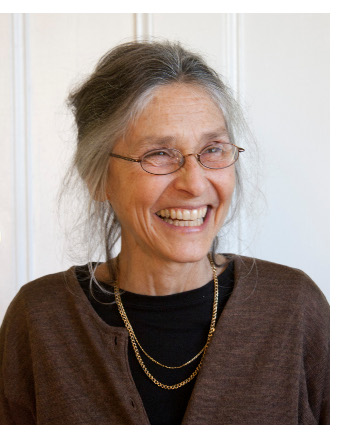 In early May, fans of the work of Claire A. Nivola will be happy to see Star Child hit shelves (Frances Foster Books/Farrar Straus Giroux). It’s an extraordinary, brand-new story from Claire, and I like it a lot. I reviewed this for BookPage, so you can read about it here.
In early May, fans of the work of Claire A. Nivola will be happy to see Star Child hit shelves (Frances Foster Books/Farrar Straus Giroux). It’s an extraordinary, brand-new story from Claire, and I like it a lot. I reviewed this for BookPage, so you can read about it here.
Today, Claire (pictured here) is visiting to talk a bit about the book, and we can also take a look at some of the art from it.
I interviewed Claire here at 7-Imp in 2011, and it remains one of my favorite interviews. To make sense of what we talk about here today (assuming you haven’t already seen, say, an early copy of the book), since it’s an unusual story, be sure to read the review first and then return, if you’re so inclined, for her thoughtful responses.
I’m always happy when she visits 7-Imp, and I thank her for taking the time to do so.
Enjoy.
Jules: How did this story come to you?
Claire: I have in front of me a tiny handmade “book” (1 3/4 x 2″), bound with a single staple, written by hand, and hastily illustrated with markers. Its title is “The Star Child,” and it is dedicated by me to my son on August 1988, when he was five years old. The idea is all there — tossed off in rough form, 26 years ago!
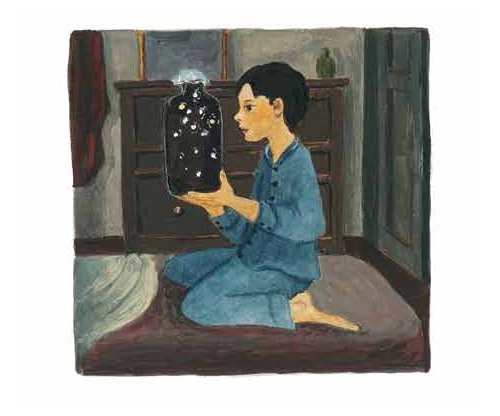
My father had died in that same year, just three months earlier, and as I say on the back flap of Star Child, the idea for the story came to me in response to the mystery of my father’s death (where does all the plenitude that a person has been, go to?), combined with the wonder I had felt at the birth of my son five years earlier (where does all that an infant already is, come from?). In Star Child, I am in no way trying to provide an explanation, but only to express the awe we feel in the face of these two ordinary, but utterly extraordinary, events.

Jules: The Kirkus review describes it as a “fanciful, thoughtful examination of a life well-lived.” I had planned to ask if you had anyone in particular in mind when you wrote it, but you just answered that!
Claire: I had no particular person in mind, though the boy looks somewhat like my son (who looks somewhat like my father), and I did base some illustrations on photographs of my son when he was little. But no, I was not trying to portray any particular life, nor a “life well-lived.” In fact, I wanted the Star Child’s life on earth to be almost generic, anyone’s life, anyone’s life anywhere. That’s why he sometimes appears in a jungle with exotic animals, and at another point he’s walking away from a stark New England village. He is anyone and everyone.
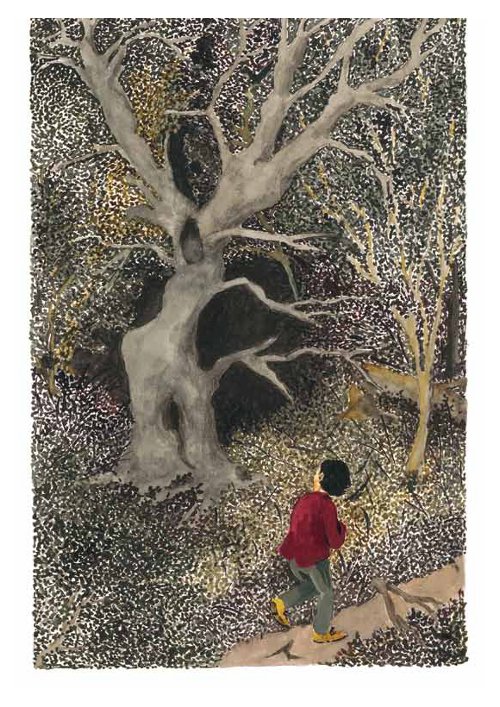
The story doesn’t presume to answer the big questions of why we are here or the meaning of life; the Star Child simply experiences life on earth and, like all of us, tries to make sense of that experience while caught up in confusion and wonder. That he has a chance to experience life is what matters. The colors, sounds, movement, ranges of emotions, all are the opposite of the eternal tranquility of the star he comes from. At the end, he affirms that the visit was worth it. I added that affirmation late in my many versions, as the affirmation became stronger in me.
The story is more of a fable that allows us to question and wonder.
sensations, and sounds will wash over you constantly.”
(Click to enlarge spread)
Jules: Did you go through a lot of drafts?
Claire: My editor of many years, Frances Foster, and I went back and forth about the story over many years, often setting it aside for long stretches. My original versions—my intention—was to cover the full life cycle through youth, maturity, old age, and the death/return to the star of origin. It never really was a book for “children.” In fact, it was friends of my son and daughter, now in their mid- and late-twenties, who most enthusiastically appreciated the story. And yet, I couldn’t quite give up on the idea. …
A few years ago, after conferring with colleagues, Frances asked me to shift the emphasis to the early portion of the life cycle: to childhood. I did just that but felt that now by implication it was a child who had to return to its star, who had to “die.” My husband suggested that I make one spread that would encompass the passing of the years from youth to old age, and that is what I did.
Jules: Your paintings here are so beautiful.
(Click to enlarge spread)
Claire: In the illustrations, I wanted to convey the brightness, variety, stimulation, colorfulness, moodiness — the sheer aliveness of life on earth! I tried some partial bleeds here and there with, in my opinion, mixed success. I had never tried that before!
Frances Foster, to whom the little book is dedicated, after many years of mulling this story over with me, had a stroke just as the project was nearing completion. It was graciously taken to a close by others at FSG, Joy Peskin as editor and Roberta Pressel as designer, but I will never think of it as anything but a story I made with Frances. We went through much of the life cycle together!

One more thought about Star Child may seem almost obvious to those who have seen some of my other books — though it wasn’t a conscious message when I conceived the story. The first photo of earth taken from space in 1968 is not unlike what the Star Child sees from his star.
That image became iconic for the environmental movement. And I think the whole Star Child story, though it tells of the human life cycle, is imbued with a sense of the wonders of our little planet and of how lucky we are, on balance, to have the amazing chance to live a life on it. My concern for the fate of those “tiny bright swirls of blue ocean and green land turning…in space” has sadly and alarmingly only intensified.
(Click to enlarge spread)
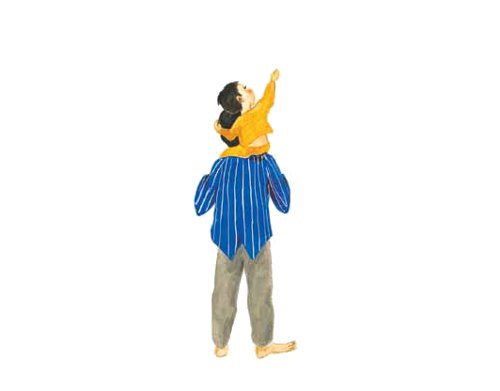
Photo of Ms. Nivola taken by Anther Kiley and used by her permission.
STAR CHILD. Copyright © 2014 by Claire A. Nivola. Published by Frances Foster Books/Farrar Straus Giroux, New York. Illustrations used by permission of the publisher.
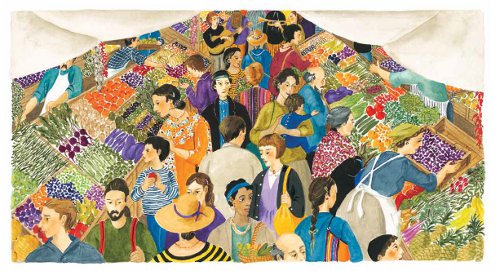
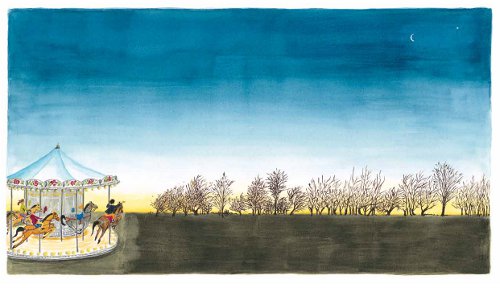
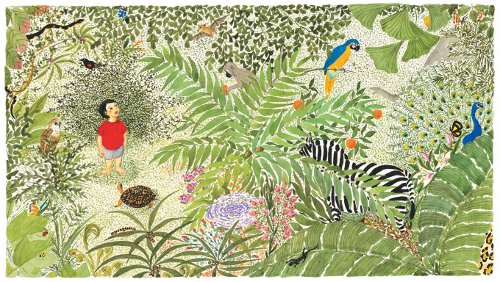

I love what Claire Nivola says about making art and about family life. If painting is the dessert (after the work of sketches and words), Star Child is dessert after reading your earlier interview and Star Child review. Such reverence for art and life comes shining through it all – Claire’s work and yours. Thank you!
I love this art! The piece of the child walking through the forest should live in my house. Oh wait, it can…when I buy the book!
Do you know how I can get a copy of “Star Child” by Claire Nivola? I’d love to have one for my grandchildren. Thanks
I’m not really sure, Steve. Wish I had a better answer for you. Try to find sellers online, I suppose? Good luck!
Hi, could you help us to have a mail contact with Claire Nivola? We are a (small) French publishing house (éditions de l’éclat), and we would like to publish different texts of Costantino Nivola and (maybe) something from Claire Nivola on his father.Best michel